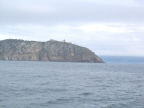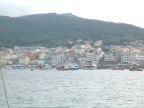25th July 2005
South from La Coruņa: the Rias BaixasWith Gerrys departure and the arrival of Kate, Jane and Christine on the same day, I rented a car to drive to Santiago de Compostela. Splitting the cost 5 ways would be economical as well as less hassle for all involved. But it also allowed Gerry and I the chance to see some of the old part of Santiago. The city is famous as the burial place of St James and has been a pilgrimage destination since medieval times. There are three routes to get there from the French Pyrenees and today still many people still do it on foot or by bike. We wandered around the narrow streets which were not as touristy as we had expected, though it was the first time I had seen shops actively trying to hawk their goods in ages. We went into the monastery of St Martin which was really impressive. The church had a large ornate altarpiece with a choir behind which reminded me of the protestant churches in Dublin. To the sides were smaller altars, also very ornate and unique. Each seemed to have a different theme and patron.



The next morning we headed across the Ria to Sada and its large marina. I needed to sort out my bowtruster and take on fuel. I got out the diving gear to have a look under the water at the prop but found that, after removing it all looked well. I then had to find out how to remove the motor inside the boat to see if the shear pin was broken. After phone calls to Ireland, Norway and Barcelona, I got to talk to a dealer in La Coruņa who advised me on how to remove the motor and ordered the relevant parts, even coming to the boat a few days later to deliver them. Great service! Sada itself is a bit of a yachting centre with chandleries, etc and a big supermarket next door. We had a hot day there while I fiddled and the next day we headed off to El Ferrol, another biggish city not too far away. But once out we found strong winds and rough seas and so had to run before the winds into La Coruņa. Christine got the chance to surf the boat in 2 metre seas into the port. We anchored for a while wailing for it to ease, But getting ashore by dingy would have been very damp, so we upped anchor and went into the new marina in the centre of the city. It was well located, although its facilities were currently in portacabins awaiting the construction of a dedicated marina building. With Derrick Adams arriving from the UK the next day, it meant that we could relax while we waited for him and the parts for the bowthruster to arrive. The parts were delayed, which did not unduly upset us as the strong winds and rough seas still needed to abait. But finally with the bowthruster working and everyone keen to move on we headed off west and south towards the Rias Baixas, the southern fjords of Galicia. We had a cracking sail with winds at 90 degrees allowing us to cream along at a steady 7+ knots on moderate seas.



On passing the Islas Sisgardas we turned south and up went the Ghoster. From there things went wrong. I got the flag that I leave at the top of the mast caught in the pulley at the top of the mast that I use for hoisting the sail and it wouldn't come down when the wind died. This meant 3 trips up the mast in rolling seas to try to rig up another way of getting the sail down. Evantually as we were entering the Ria of Canariņas the seas were easy enough for me sort it out. We got the sail down and after another half an hour up the top of the mast, the pulley was unjammed, but sadly the flag will never fly again. Needless to say, I was shattered after all the effort. Luckily, Kate rustled up a great pasta feed that night which filled the hole. Camariņas itself is a lovely anchorage, though we didn't care too much for the town which had too many boy racers speeding around.



The next morning Jane and Christine were able to go for a dive while Kate and I did the shopping. After that we motored on calm seas further south, heading for Finisterre, the end of the world. Kate decided that we would go there, rather than going on further. The guide book didn't sound enthusiastic, saying it was a fishing town which wasn't welcoming to yachts. We found a lovely working town not full of tourists and really enjoyed our stay.



That night a lot of wind came through but the morning dawned overcast and calm. We had already got the dingy aboard and so motored off immediately, heading for the next Ria: Muros. Here we were going to the Portosin yacht club where we hoped to organise transport for the girls who were heading home the next day. A meal out in the club topped off the evening. A great way to say goodbye to crew. I think the girls enjoyed their trip, having lazy slow sailing days, windy days, and some drama with bowthrusters and sails stuck up the mast. I think they got a good picture of what sailing is really like and I hope it makes them come back for more next year.







As I write the wind is howling outside and the forecast looks like we are going to have strong winds for the next few days. The high pressure system around the Azores isn't doing its job of blocking out depressions crossing the Atlantic from entering Biscay. As a result its time for doing little odd jobs on the boat and chilling out with a book and the occasional glass of wine.